Papers by Dr. Goutam Thakur
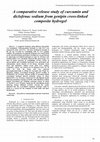
— A composite hydrogel, using chitosan and gelatin was formulated. Chitosan-gelatin hydrogel in r... more — A composite hydrogel, using chitosan and gelatin was formulated. Chitosan-gelatin hydrogel in ratio 0.5:1 was prepared in lactic acid (2%). The poor mechanical strength of the gel was overcome by crosslinking with 1% (w/v) genipin solution. The properties of composite hydrogel were tested based on the characterizations performed. Swelling test was performed by immersing cross-linked hydrogels in water for 20 hours and swelling indices were calculated. Infrared (IR) spectroscopy was done to ensure presence of crosslinking. In-vitro release of uncross-linked and crosslinked hydrogels were performed and subsequently, release kinetics of two drugs: curcumin (weak base) and diclofenac sodium (weak acid) were studied. Cumulative release was carried out in deionized water for 30 hours for both the drugs and was analyzed spectrophotometrically at 265nm for curcumin and 276nm for diclofenac sodium. Cross-linked hydrogel showed swelling of 99.28±0.04% for 20 hours. Release profile of curcumin loaded cross-linked hydrogel showed sustained release of about 80.04±0.54% over 30 hours; found best fit with Higuchi model following anomalous transport (n=0.90), while diclofenac sodium loaded cross-linked gel exhibited sustained release of about 71.72±0.04 % over 30 hours; found best fit with Higuchi model following Fickian diffusion (n=0.45). Overall, the results indicated that the cross-linked composite hydrogel could be tuned as a carrier for the transport of both acidic and basic biomolecules.
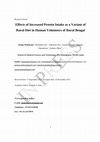
JMED Research, 2013
Constant escalations in the number of diabetics’ worldwide, associated complications and financia... more Constant escalations in the number of diabetics’ worldwide, associated complications and financial implications, failure of conventional the rapy regimen to restore normoglycemia has brought to limelight the non-pharmacologic mean s like lifestyle and dietary interventions as one of the effective aids to combat type 2 diabetes. Economy, education,preference plays a role in dietary selection. Prolonged intake of carbohydrate enriched diet was found to be a causative of diabetes amongst poor rural Indian population of Bengal. Contrastingly, current research of three years RCT /amongst rural Bengalis have shown that a daily increase in protein intake by 25-30% when compared with standard rural diet comprising of about 70% to 80% of carbohydrate, 10% fats and 10% protein, improved insulin sensitivity and lowered fasting blood glucose level amongst experimental population significantly (p=0.04) rather than the control group. Fasting serum insulin value decreased from 47±2.2 pmol/l to 44±2.4 pmol/l (p=0.04) in the study group but amongst controls an increment from 42±2.4 pmol/l to 43±2.4 pmol/l was observed. Fasting Blood Sugar level amongst controls was initially 103±4 mg/dl and became 105±6 mg/dl but in the experimental group initial value of 109±12 mg/dl diminished to 103±8 mg/dl (p=0.04) at the end of 3 years follow up. However blood lipid parameters (TC, LDL, HDL, and VLDL) were not significantly influenced by higher daily protein intake both in control and experimental group. Thus a conclusive fact found from the trial is that protein enriched,low carbohydrate diet can offer a positive impact on glycemic control kidney functions remaining normal.
Polymer-Plastics Technology and Engineering (2013) (In press)
Hydrogels have evolved in the last decade as materials of choice in varied biomedical application... more Hydrogels have evolved in the last decade as materials of choice in varied biomedical applications. This may be associated with the inherent biocompatible nature of the hydrogels. The modulation of the properties of the hydrogels is easily possible due to the presence of polymers of varied chemistry and physical properties. This review discusses the pharmaceutical aspect of the controlled release of bioactive agents from hydrogel based formulations.
By virtue of their capacity to retain significant amounts of fluid within their polymeric network... more By virtue of their capacity to retain significant amounts of fluid within their polymeric networks, hydrogels have been used for innumerable biomedical applications. This chapter highlights hydrogel-based drug delivery and tissue engineering applications based on naturally-occurring biopolymers. It provides a comprehensive review of the biopolymers commonly used in such applications, how hydrogels are typically prepared and characterized, the importance of crosslinking in modulating gel release properties and rheology, examples of recent applications and possible future applications for novel hydrogels.
Gelatin gels are three-dimensional networks of macromolecular chains, physically cross-linked thr... more Gelatin gels are three-dimensional networks of macromolecular chains, physically cross-linked through hydrogen bonding. The use of gelatin gels as a matrix for drug delivery is limited due its reversible gel-sol transition at~ 35oC and potentially low gel strength. As a result, gelatin is often chemically crosslinked to increase its thermal stability and rigidity. Genipin, a natural low-cytotoxicity crosslinker of amino groups, has been shown to improve gelatin's mechanical properties for biomedical applications.
Wound healing is a complex process and is promoted by dressings that maintain a moist environment... more Wound healing is a complex process and is promoted by dressings that maintain a moist environment but allow excess fluid to escape without permitting wound desiccation. Chitosan is biodegradable, biocompatible, non-toxic and antithrombogenic, thus allowing it to be a good biomaterial for wound management, space filling implants etc. This study aims at the development of advanced biomaterial having desirable mechanical as well as biological properties for wound management.
This chapter highlights select gelatin-based carrier matrices which are seeing more frequent use ... more This chapter highlights select gelatin-based carrier matrices which are seeing more frequent use as drug delivery systems. Gelatin gels, alone and in combination with other polymers, can act as carriers for the delivery of various bioactive molecules. Controlled release systems and their underlying mechanisms along with mathematical modeling are outlined to show the various means by which target compounds are released from gelatin-based systems. Biocompatibility and applications of gelatin-based carriers in the fields of medicine and biomedical research are discussed.

Journal of Tissue Engineering and Regenerative Medicine, Sep 2012
Gelatin based drug carrier matrices have gained intense interest as a very promising class of del... more Gelatin based drug carrier matrices have gained intense interest as a very promising class of delivery system. The aim of this study was to develop drug (tolbutamide) loaded gelatin based gels. Gelatin gel due to its reversible gel-sol transition at ~35°C and potentially low gel strength is often chemically crosslinked to improve its thermal and mechanical stability. Here, gelatin matrices were crosslinked with genipin, a naturally occurring crosslinker for the release of tolbutamide. Tolbutamide (anti-diabetic agent) was incorporated into the gelatin matrices to form drug loaded gel for the release study. Morphological analysis using confocal microscopy revealed network structure. The release of tolbutamide from the crosslinked gels indicated an initial increase upto 8 h. This was followed by a steady release state after 20 h (52%). Release kinetics was determined following Peppas model. The diffusional exponent (n) (0.84±0.01) (p<0.05) indicated anomalous release behaviour. Further, in vitro cellular compatibility and normal cell proliferation of AH-927 cell line was observed in live dead assay and fluorescence microscopy studies using propidium iodide staining. The studies supported that the matrices display excellent compatibility without compromising the cellular integrity and thus can be utilized as safe carrier matrices for drug transport.
Keywords: Genipin, crosslinking, gelatin hydrogel, drug release, cytocompatibility

Though chitosan hydrogels have shown potential for numerous tissue regeneration applications, its... more Though chitosan hydrogels have shown potential for numerous tissue regeneration applications, its insolubility above pH 6.0 have greatly limited applicability in encapsulation of live cells and pH sensitive bioactive agents. In this report an approach to overcome this limitation was tested with phosphorylated derivative of chitosan, N-methylene phosphonic chitosan (NMPC). NMPC is also known to possess efficacious gene delivery, iomineralization and osteoinduction properties. NMPC hydrogels were synthesized by crosslinking NMPC with either glutaraldehyde (NMPC-GLU) or genipin (NMPC-GEN). An increase in pH from 3.0 to 6.8 reduced gelation time with both the agents, with the reduction more pronounced in NMPC-GLU. The results correlated with the reaction mechanisms of both agents with NMPC. Further NMPC-GEN gels demonstrated higher elastic modulus and ompressive strength values. Cell culture studies showed higher cell proliferation on NMPC-GEN compared to NMPC-GLU
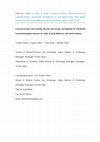
Drug delivery is a promising technique to enhance the therapeutic efficacy of the drug. However, ... more Drug delivery is a promising technique to enhance the therapeutic efficacy of the drug. However, properties of carrier materials require intense improvement for effective transport of drug molecules. In the current study, attempts have been made to develop freeze dried gelatin matrices cross linked with genipin at various temperatures (5ºC, 15ºC and 25ºC) prior to freeze-drying (-80ºC). The freeze dried matrices thus obtained at the said temperatures are characterized for crosslinking density, compression strength, swelling behaviors. The matrix crosslinked at 25ºC showed highest Flory Rehner crosslinking density (467±46) (p<0.05), highest compressive strength (12.36±0.12) (p<0.05) and lowest equilibrium water content. In this context, scanning electron microscopy (SEM) was performed to study the surface morphology (size and shape of pores) of the crosslinked matrices. These images were further processed for quantitative analysis of morphological features viz., areas, radius, ferret diameter, length of major and minor axis and eccentricity using MATLAB toolboxes. These quantitative analyses correlate transport and the release kinetics of model anti-inflammatory drug (indomethacin) from crosslinked matrices in vitro to tune as a controllable delivery system. The diffusional exponent (n) for all constructs ranging from 0.61-0.69 (p<0.05) (0.45<n<0.89) indicated non-Fickian release kinetics
One important therapeutic approach for the treatment of Type 2 Diabetes Mellitus is by decreasing... more One important therapeutic approach for the treatment of Type 2 Diabetes Mellitus is by decreasing the postprandial increase of glucose. This is possible by inhibiting certain carbohydrate hydrolyzing enzymes like alpha-amylase. In the present study, the inhibitory effect of tannins isolated from the alcoholic extract of fruits of Terminalia chebula was evaluated for the first time with porcine pancreatic amylase and potato starch as substrate. The result indicated that highest inhibition (52%) was obtained at the concentration of l00 microgram/ml of tannins extracted from the fruits. The result was comparable to that of Acarbose which is a very effective antidiabetic agent.
In recent years, chitosan, a biocompatible natural polymer, having a cellulosic backbone has gain... more In recent years, chitosan, a biocompatible natural polymer, having a cellulosic backbone has gained much importance in various biomedical applications like wound healing, tissue
engineering, surface modifications of the implantable devices and drug delivery. This may be attributed to the versatile chemistry of the polymer. Various chitosan-mediated delivery systems have been developed to improve the bioavailability of drug(s) and be categorized either as nanoparticulate, microparticulate or macro delivery systems. All these delivery systems have their own advantages and limitation as a delivery vehicle. This review gives an overview of the chitosan-based drug delivery systems.
Keywords: Chitosan, nanoparticle, microparticle, hydrogels

"Oil-in-water emulsion gels consisting sunflower oil as the internal phase and a chemically-cross... more "Oil-in-water emulsion gels consisting sunflower oil as the internal phase and a chemically-crosslinked gelatin solution as the continuous aqueous phase were developed. The dispersion was homogenized at 60°C in a high pressure valve homogenizer at a pressure of 5000/500psi for different time periods (2, 5 or 10min). The homogenized samples were formed into films at 5°C followed by crosslin king with genipin at room temperature. The microstructure of the gels was studied using confocal laser scanning microscopy. The results showed significant differences in the microstructure depending on homogenization time. Gel micrographs indicated a well-dispersed network of sunflower oil droplets in the gelatin matrix with a higher homogenization duration (10 min) while a less unorganized gel microstructure was evident at shorter homogenization times (2 and 5 min). Gels
were also characterized using colourimetric analysis. Puncture tests of the gels were tested to establish their mechanical stability. The gels prepared with 10 min homogenization exhibited the highest puncture strength (0.23±0.20 MPa) (p<0.05). These results demonstrated that gelatin gels homogenized for longer periods were more stable, thus expanding their range of possible
biomedical applications.
Keywords- gelatin; emulsion gel; homogenization; genipin;
crosslin king; microstructure"
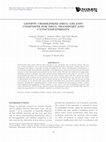
"Gelatin based drug carrier matrices have emerged as very promising class of delivery system. The... more "Gelatin based drug carrier matrices have emerged as very promising class of delivery system. The purpose of this investigation was to develop drug loaded gelatin based
gels (composites). Gelatin matrices were crosslinked with genipin, a naturally occurring crosslinker for the release of indomethacin. Indomethacin, a low molecular weight and moderately hydrophobic, anti-inflammatory agent was incorporated into the gelatin matrices to form drug loaded gel composites for the release study. The gels were subjected to temperature-dependent oscillatory rheology. The result showed pouring temperature in the range of ~31-34°C for the un-crosslinked gels while the crosslinked gels didn’t show crossover point. Gels were studied for surface morphology using scanning electron microscopy and a porous network structure was observed. The release of indomethacin from the gels indicated an initial increase in the release rate with the increase in drug concentrations. It was observed that drug composites with higher drug concentration, exhibited higher drug transport. Swelling and cross linking played crucial role in regulating the drug transport. Further, viability assay suggested biocompatibility of these matrices in vitro. Gel in vitro cell compatibility using live dead assay was evaluated with AH-927 cell line indicated normal cell proliferation without any harmful effect and thus suggesting appropriateness of crosslinked composites as potential drug carrier.
Keywords: Genipin, crosslinking, gelatin composite, drug release, cytocompatibility"
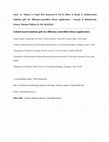
Emulsion gels are now emerging as a new class of biomaterials for controlled release applications... more Emulsion gels are now emerging as a new class of biomaterials for controlled release applications. Novel food-grade emulsion gels consisting of indomethacin-loaded vegetable oil droplets dispersed within genipin-crosslinked gelatin-based hydrogels were characterized for their physical and drug release properties. Varying the weight ratio of the aqueous and oil phases between 5:1 and 5:5 was used to modulate construct swelling and drug release. The dispersed oil droplets generally became larger, more polydispersed and aggregated with an increase in oil fraction. Crosslinking with genipin increased the puncture strength of the gels vs. their uncrosslinked counterparts and was necessary to prevent breakdown. Swelling of the emulsion gels demonstrated Fickian behaviour at all gelatin: oil ratios. Indomethacin release followed Fickian diffusion at higher oil fractions only, demonstrating coupled Fickian and Super-Case II transport at lower oil ratios (5:1, 5:2 and 5:3). Overall, the introduction of a dispersed oil phase within a hydrogel was exploited for the release of hydrophobic bioactive compounds, with tailoring of composition used to significantly alter release kinetics.

Hydrogels are extensively studied as carrier matrices for the controlled release of bioactive mol... more Hydrogels are extensively studied as carrier matrices for the controlled release of bioactive molecules. The aim of this study was to design gelatin-based hydrogels crosslinked with genipin and study the impact of crosslinking temperature (5, 15 or 25°C) on gel strength, microstructure, cytocompatibility, swelling and drug release. Gels crosslinked at 25°C exhibited the highest Flory–Rehner crosslink density, lowest swelling ratio and the slowest release of indomethacin (Idn, model anti-inflammatory drug). Diffusional exponents (n ) indicated non-Fickian swelling kinetics while drug transport was anomalous. Hydrogel biocompatibility, in vitro cell viability, cell cycle experiments with AH-927 and HaCaT cell lines indicated normal cell proliferation without any effect on cell cycle. Overall, these results substantiated the use of genipin crosslinked hydrogels as a viable carrier matrix for drug release applications
Diabetes mellitus (DM), a clinical manifestation characterized by chronic hyperglycaemia, is ofte... more Diabetes mellitus (DM), a clinical manifestation characterized by chronic hyperglycaemia, is often ascribed to either a defect in insulin secretion, insulin resistance or both. Ayurveda (Indian Traditional Medicinal System) have shown promising results in the treatment of diabetes using various plants and herbs with negligible side effects and cost effective treatment. However, only a limited number of these plants have been explored and scientifically validated for their hypoglycemic effect. This review highlights some of the plants being commonly used in India for their hypoglycaemic effects.
"The current study deals with the synthesis of novel hydroxypropyl methyl cellulose acrylate (HPM... more "The current study deals with the synthesis of novel hydroxypropyl methyl cellulose acrylate (HPMCAA) by the process of esterification of hydroxypropyl methyl cellulose and acryloyl chloride. The polymers were characterized by FTIR spectrophotometry, DSC, XRD and haemocompatibility studies. The microstructures of the HPMC and HPMCAA powders were studied under a scanning electron microscope. The powders were used as an excipient for the preparation of lactose tablets and their composition was varied from 2% to 8 % (w/w) of the total tablet weight. Disintegration studies for the tablets were carried out. The results indicated formation of a new product, HPMCAA, having properties different from HPMC. HPMCAA was found to be haemocompatible in nature. Disintegration tests indicated that HPMCAA could be tried as a superdisintegrating
agent."
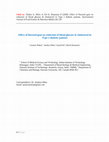
The effects of ingestion of flaxseed gum on blood glucose and cholesterol, particularly low densi... more The effects of ingestion of flaxseed gum on blood glucose and cholesterol, particularly low density lipoprotein cholesterol, in type 2 diabetes were evaluated. Flaxseed gum was incorporated in wheat flour chapattis. Sixty patients of type 2 diabetes were fed a daily diet for 3 months, along with six wheat flour chapattis containing flaxseed gum (5 g), as per the recommendations of the American Diabetic Association. The control group (60 individuals) consumed an identical diet but the chapattis were without gum. The blood biochemistry profiles monitored before starting the study and at monthly intervals showed fasting blood sugar in the experimental group decreased from 154±8 mg/dl to 136±7 mg/dl (P=0.03) while the total cholesterol reduced from 182±11 mg/dl to 163±9 mg/dl (P=0.03). Results showed a decrease in low-density lipoprotein cholesterol from 110±8 mg/dl to 92±9 mg/dl (P=0.02). The study demonstrated the efficacy of flax gum in the blood biochemistry profiles of type 2 diabetes. Keywords: Type 2 diabetes, flaxseed gum, fasting blood sugar, total cholesterol, low-density lipoprotein

"Background: The prevalence of Type 2 diabetes is increasing in rural areas of India, where there... more "Background: The prevalence of Type 2 diabetes is increasing in rural areas of India, where there is also often a lack of health infrastructure. Thus, a proper dietary study with the view of combating diabetes is essential. The aim of the present study was to determine the long-term effect of a carbohydrate-rich diet in rural Bengal.
Methods: Volunteers (n = 320) were selected from three villages in Kharagpurand were randomly divided into a control and experimental group (n = 160 in each). The design of the study was such that non-significant differences in any of the dependent variables were maintainted prior to the application of control or treatment modes. In the control group, volunteers consumed <70% carbohydrate as part of their diet, whereas in the experimental group carbohydrate consumption was >70%. Blood samples from both groups were collected on yearly basis for 5 years and fasting blood sugar (FBS), lipid profile and serum insulin values were analyzed.
Results: The blood biochemistry profiles were monitored before the start and at the end of the study. The results indicate that increased intake of carbohydrate causes significant increases in FBS (P < 0.05) and serum insulin (P < 0.05), as well as changes in the lipid profile, particularly triglycerides (P < 0.05) and very low-density lipoprotein–cholesterol (VLDL-C; P < 0.05).
Conclusions: The effects of increased carbohydrate on FBS, serum insulin,triglycerides and VLDL-C indicate that a proper nutritional policy needs to be implemented for this population of rural, low-income Bengalis.
Keywords: carbohydrate, diet, rural population, Type 2 diabetes."




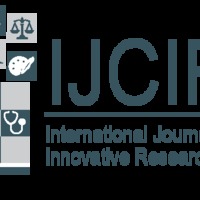



Uploads
Papers by Dr. Goutam Thakur
Keywords: Genipin, crosslinking, gelatin hydrogel, drug release, cytocompatibility
engineering, surface modifications of the implantable devices and drug delivery. This may be attributed to the versatile chemistry of the polymer. Various chitosan-mediated delivery systems have been developed to improve the bioavailability of drug(s) and be categorized either as nanoparticulate, microparticulate or macro delivery systems. All these delivery systems have their own advantages and limitation as a delivery vehicle. This review gives an overview of the chitosan-based drug delivery systems.
Keywords: Chitosan, nanoparticle, microparticle, hydrogels
were also characterized using colourimetric analysis. Puncture tests of the gels were tested to establish their mechanical stability. The gels prepared with 10 min homogenization exhibited the highest puncture strength (0.23±0.20 MPa) (p<0.05). These results demonstrated that gelatin gels homogenized for longer periods were more stable, thus expanding their range of possible
biomedical applications.
Keywords- gelatin; emulsion gel; homogenization; genipin;
crosslin king; microstructure"
gels (composites). Gelatin matrices were crosslinked with genipin, a naturally occurring crosslinker for the release of indomethacin. Indomethacin, a low molecular weight and moderately hydrophobic, anti-inflammatory agent was incorporated into the gelatin matrices to form drug loaded gel composites for the release study. The gels were subjected to temperature-dependent oscillatory rheology. The result showed pouring temperature in the range of ~31-34°C for the un-crosslinked gels while the crosslinked gels didn’t show crossover point. Gels were studied for surface morphology using scanning electron microscopy and a porous network structure was observed. The release of indomethacin from the gels indicated an initial increase in the release rate with the increase in drug concentrations. It was observed that drug composites with higher drug concentration, exhibited higher drug transport. Swelling and cross linking played crucial role in regulating the drug transport. Further, viability assay suggested biocompatibility of these matrices in vitro. Gel in vitro cell compatibility using live dead assay was evaluated with AH-927 cell line indicated normal cell proliferation without any harmful effect and thus suggesting appropriateness of crosslinked composites as potential drug carrier.
Keywords: Genipin, crosslinking, gelatin composite, drug release, cytocompatibility"
agent."
Methods: Volunteers (n = 320) were selected from three villages in Kharagpurand were randomly divided into a control and experimental group (n = 160 in each). The design of the study was such that non-significant differences in any of the dependent variables were maintainted prior to the application of control or treatment modes. In the control group, volunteers consumed <70% carbohydrate as part of their diet, whereas in the experimental group carbohydrate consumption was >70%. Blood samples from both groups were collected on yearly basis for 5 years and fasting blood sugar (FBS), lipid profile and serum insulin values were analyzed.
Results: The blood biochemistry profiles were monitored before the start and at the end of the study. The results indicate that increased intake of carbohydrate causes significant increases in FBS (P < 0.05) and serum insulin (P < 0.05), as well as changes in the lipid profile, particularly triglycerides (P < 0.05) and very low-density lipoprotein–cholesterol (VLDL-C; P < 0.05).
Conclusions: The effects of increased carbohydrate on FBS, serum insulin,triglycerides and VLDL-C indicate that a proper nutritional policy needs to be implemented for this population of rural, low-income Bengalis.
Keywords: carbohydrate, diet, rural population, Type 2 diabetes."
Keywords: Genipin, crosslinking, gelatin hydrogel, drug release, cytocompatibility
engineering, surface modifications of the implantable devices and drug delivery. This may be attributed to the versatile chemistry of the polymer. Various chitosan-mediated delivery systems have been developed to improve the bioavailability of drug(s) and be categorized either as nanoparticulate, microparticulate or macro delivery systems. All these delivery systems have their own advantages and limitation as a delivery vehicle. This review gives an overview of the chitosan-based drug delivery systems.
Keywords: Chitosan, nanoparticle, microparticle, hydrogels
were also characterized using colourimetric analysis. Puncture tests of the gels were tested to establish their mechanical stability. The gels prepared with 10 min homogenization exhibited the highest puncture strength (0.23±0.20 MPa) (p<0.05). These results demonstrated that gelatin gels homogenized for longer periods were more stable, thus expanding their range of possible
biomedical applications.
Keywords- gelatin; emulsion gel; homogenization; genipin;
crosslin king; microstructure"
gels (composites). Gelatin matrices were crosslinked with genipin, a naturally occurring crosslinker for the release of indomethacin. Indomethacin, a low molecular weight and moderately hydrophobic, anti-inflammatory agent was incorporated into the gelatin matrices to form drug loaded gel composites for the release study. The gels were subjected to temperature-dependent oscillatory rheology. The result showed pouring temperature in the range of ~31-34°C for the un-crosslinked gels while the crosslinked gels didn’t show crossover point. Gels were studied for surface morphology using scanning electron microscopy and a porous network structure was observed. The release of indomethacin from the gels indicated an initial increase in the release rate with the increase in drug concentrations. It was observed that drug composites with higher drug concentration, exhibited higher drug transport. Swelling and cross linking played crucial role in regulating the drug transport. Further, viability assay suggested biocompatibility of these matrices in vitro. Gel in vitro cell compatibility using live dead assay was evaluated with AH-927 cell line indicated normal cell proliferation without any harmful effect and thus suggesting appropriateness of crosslinked composites as potential drug carrier.
Keywords: Genipin, crosslinking, gelatin composite, drug release, cytocompatibility"
agent."
Methods: Volunteers (n = 320) were selected from three villages in Kharagpurand were randomly divided into a control and experimental group (n = 160 in each). The design of the study was such that non-significant differences in any of the dependent variables were maintainted prior to the application of control or treatment modes. In the control group, volunteers consumed <70% carbohydrate as part of their diet, whereas in the experimental group carbohydrate consumption was >70%. Blood samples from both groups were collected on yearly basis for 5 years and fasting blood sugar (FBS), lipid profile and serum insulin values were analyzed.
Results: The blood biochemistry profiles were monitored before the start and at the end of the study. The results indicate that increased intake of carbohydrate causes significant increases in FBS (P < 0.05) and serum insulin (P < 0.05), as well as changes in the lipid profile, particularly triglycerides (P < 0.05) and very low-density lipoprotein–cholesterol (VLDL-C; P < 0.05).
Conclusions: The effects of increased carbohydrate on FBS, serum insulin,triglycerides and VLDL-C indicate that a proper nutritional policy needs to be implemented for this population of rural, low-income Bengalis.
Keywords: carbohydrate, diet, rural population, Type 2 diabetes."